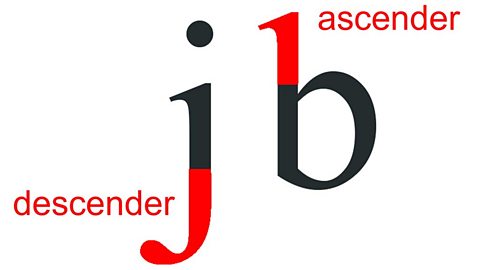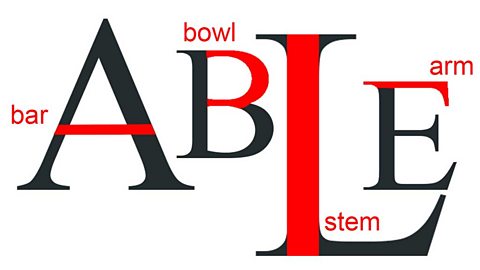Structure of letters

All letters sit on the baselineThe line that letters sit on. A capital letterÔÇÖs height is known as the cap heightThe height of a typeface's capital letters. The height of a lower case x is called the x-heightThe height of the lower case letter , and the top of this is the meanlineA line at the top of the x-height of a typeface This is used to define the size of all the lower case letters. Using these measurements consistently in a typeface makes sure that all the letters work together. This creates unity.
Ascenders and descenders

The part that goes below the baseline is called a descenderThe part of a letter that goes below the baseline - eg the bottom part of a 'p' or 'q'. The part that goes above the meanline is called an ascenderThe part of a letter that goes above the meanline - eg the top part of a 'b' or 'd'.
Bar, arm, stem and bowl

Letters like A, e, f, H and t, have a part which goes across, this is known as the barThe part of an uppercase letter goes along the meanline - eg the horizontal line in 'A' or the middle line in 'E' (also called a cross-bar) or crossbar.
Uppercase letters, E, F, T and Z, all have a part across the top or bottom of the letter known as the armThe horizontal part at the top or bottom of an uppercase letter - eg 'T' has one arm and 'E', 'F' and 'Z' each have two arms.
The stemThe part of a letter that is a vertical line - eg in the letters 'B', 'b', 'D' and 'h' is a straight, vertical part, eg the letters B, D, F, H, L, R, b, d, t and l all have a stem.
Letters such as B, D, p, q, R, b and d all have a round curve which is known as the bowlThe round curve of a letter such as in the letters 'B', 'd' or 'g'.
Question
What is the meanline of a typeface?
The meanline is the line that is level with the top of a lower case ÔÇÿxÔÇÖ. It is used as a way to keep lettering consistent throughout a typeface.